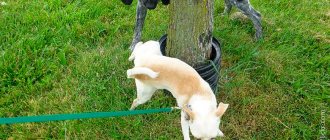Your dog's difficulty peeing can be caused by numerous factors. In any case, this is a signal that your dog has health problems. An immediate visit to the veterinarian is essential to rule out a cause and avoid serious complications that harm your dog (such as a ruptured bladder). If your dog is showing signs of being unable to urinate, one possible consequence is an overly distended bladder.
If this happens, there are numerous complications that can develop as a result, such as infection or possible urinary incontinence in the future. The normal process of urination is a complex series of actions, including certain activities such as muscle contraction and nerve function. Problems of why a dog cannot pee are more common in male dogs than in female dogs.
There are two common medical terms associated with urination in dogs. This includes voiding or incomplete emptying, or urine that is not associated with an obstruction, or "functional" urine, which is caused directly by a problem related to the normal functioning of the organ.
Symptoms
The problem of why a dog can't pee can quickly become a pressing situation. Don't hesitate to take your dog to the vet if you see any of the following symptoms:
© shutterstock
- Urine that flows in streams or streams;
- Frequent attempts to urinate (often delayed and unsuccessful);
- Display of strain when attempting to excrete urine;
- Leakage (this can happen because the bladder is so full that it can no longer hold fluid);
- Blood in the urine;
- Licking the urinary opening;
- Low appetite;
- Vomit;
- Tender abdominal area;
- Lethargy;
- Disinterest in normal activities.
Your dog needs your support.
If the dog does not urinate for a long time, then there is every chance that this symptom relates to the following diseases:
It is worth noting that they can be deadly, since the kidneys take part in the synthesis of hormones, remove excess moisture, toxins and poisons from the body, filter the blood, and are necessary for many other important functions.
Damaged kidney tissue does not recover on its own and, without proper treatment, is quickly destroyed. Considering that in the early stages this disease is almost impossible to determine, you definitely shouldn’t put off going to the doctor, because in this case the minutes count.
If you really care about your dog and want it to live to a ripe old age, do not ignore even the slightest deviation from the norm in its behavior, and visit your veterinarian regularly.
Remember that prevention is the best cure. views
Reasons why a dog can't pee
There can be many reasons leading to the inability to urinate in dogs:
- Urethral obstruction (this can be due to a blockage caused by crystals in the urine and can be caused by something as simple as not drinking enough water);
- A dog that has had many urinary tract infections may begin to have trouble urinating due to multiple bladder distentions;
- A urinary tract infection can spread to the bladder;
- Scar tissue on the urethra or bladder;
- Anatomical abnormalities (congenital or contractual);
- Spinal cord injury, lesion, or disease that causes compression;
- Nerve injury leading to compression;
- Disc herniation;
- Dysautonomia (a neurological disorder also known as Key-Gaskell syndrome);
- Some surgeries may result in inability to urinate (which is likely to be temporary);
- Cancer;
- Prostate diseases.
Diagnostics
When you arrive at the clinic or hospital, be prepared to tell the veterinarian any symptoms and behavioral changes you have seen in your dog who cannot pee. In most cases, the veterinarian will want to begin a full physical examination followed by a urine test, which may show infection or signs of inflammation. Blood tests including CBC and chemistry profile may be included.
© shutterstock
If the veterinarian has not diagnosed a simple infection or believes further investigation is necessary, a urethral catheter may be placed to rule out the possibility of a blockage. It is interesting to note that urethral obstruction is more common in male dogs due to the narrowing of the urethra on the penis.
Additional testing may include:
- Palpation of the abdomen - if the kidneys are full and the bladder is empty (anuria), this indicates a lack of urine output, which is the disease itself;
- CT to evaluate the caudal spine for tumors;
- Myelography (x-ray examination for damage to the spinal cord);
- Epidurography (X-ray test to check for spinal cysts);
- Abdominal ultrasound to check for kidney or bladder problems;
- Cystoscopy (insertion of a hose to examine inside the lower urinary tract).
Urinary incontinence
Common symptoms are sudden uncontrollable urges, involuntary urination, and constant leakage of urine in small portions. There are small wet spots on the bedding after sleep, urine is released from sudden movements. If we are not talking about a congenital pathology, older, larger dogs are more likely to suffer from incontinence. Provoking factors are excess weight, low mobility, frequent childbirth. In chronic cases, the risk of urinary tract infections increases.
| CAUSE | SYMPTOMS | TREATMENT |
| Ectopia is a structural anomaly in which the ureter protrudes into the vagina (females) or urethra (males). | Leaks in the first days after birth. The puppy smells bad. The genitals are inflamed, licked by the bitch. | The ureter is surgically removed into the bladder. |
| Sphincteric insufficiency after sterilization. Large females that are spayed after puberty are susceptible. | Involuntary bowel movements, usually in the morning and at night. Sometimes the dog constantly leaks drop by drop. | Long-term hormonal therapy aimed at maintaining sphincter function. Surgical correction is possible. |
| Complicated course of infectious diseases of the genitourinary tract. | Due to decreased receptor sensitivity, it is impossible to control urges. Urine flows randomly, first drop by drop, then in larger portions. | Elimination of infection and the cause of the disease, strengthening the immune system. |
| Injury - blow to the stomach, fall from a height. The injury initially causes delay, but the long-term consequence may be incontinence. | Due to decreased innervation of the bladder and/or sphincter, the dog ceases to feel the urge and control the process. Partial or complete incontinence may occur. | Treatment is surgical coupled with long-term therapy. The forecast is cautious. |
| Problems with urethral closure - decreased sphincter function due to congenital pathology, infection, obesity, and age-related changes. | Urine flows out even at rest, in small portions. The dog constantly licks himself, smells unpleasant, and his genitals are inflamed. | Long-term therapy, often including hormonal drugs. |
Incontinence is usually not as dangerous as urinary retention, but it does cause a lot of inconvenience for owners. It is important to remember that you should not scold your pet - stress will only make the situation worse. To minimize the consequences, you need to use diapers, remove carpets during treatment and walk longer.
You should not try to reduce the amount of drinking water in your diet - concentrated urine more irritates the walls of the organ, which leads to increased urination. It is important to follow the prescribed diet, avoid hypothermia, and exclude sweets and dairy products.
Treatment of the problem
With the reason why a dog can't pee sorted out, now we need to talk a little about what to do if your dog can't pee. Treatment will directly correlate with the exact cause of the inability to urinate. Immediate relief of your dog's discomfort, as well as the importance of treating the problem before it gets worse, will be of utmost importance. Treatment may include:
- For urinary tract infections, antibiotics are administered;
- Water consumption may be increased;
- Urine acidifiers or urine acidifiers may be prescribed;
- Your dog will be given medications to relax the bladder and urethra;
- Bladder catheterization can be performed up to three times a day;
- Manual bladder expression may be required at regular intervals (several times a day, such as in the case of spinal cord injury), depending on the cause of the inability to urinate;
- Obstruction may require surgical intervention if retropulsion of the obstructing material back into the bladder is not possible;
- Congenital pathology may require surgical correction;
- Unspayed male dogs can be treated and then neutered if the problem is the prostate.
Rest assured that your veterinarian will monitor your dog carefully. He will take all necessary steps to help a dog who cannot pee, to ensure that infection does not set in or that the problem does not progress further (for example, preventing kidney damage).
How do huskies handle the heat?
Husky is considered one of the oldest dog breeds. The owners of the first huskies were the Chukchi and Eskimos. Today there are many legends and myths about these dogs, which do not always correspond to reality. And they are not always positive. Having heard another “rumor” about a husky, some even decide not to adopt this dog. But she has so many positive aspects.
Here are some of the main advantages of dogs of this breed:
- Husky loves all people, so will love all family members;
- Huskies never bite people; cases when these dogs attacked people are an exception (this happened when they tried to re-educate the dog or damaged its psyche);
- for lovers of active recreation and an active lifestyle, the husky will become the best friend and inquisitive partner;
- Huskies don't bark at all (but sometimes they howl);
- Huskies are very original and beautiful dogs, they combine wolfish grace and the famous blue eyes.
How do huskies cope with hot climates?
Many people are interested in the question of how huskies tolerate hot climates. After all, this is a northern breed of dog. So, another undoubted advantage is that huskies adapt perfectly to any climate.
If you live in a hot climate, you should purchase a husky puppy from a kennel located in a city with the same climate. These dogs have lived in kennels for more than one day, which means they have already adapted to the local climate.
If you do not have a nursery nearby, then it is necessary to create favorable acclimatization conditions for your pet. Evening walks, plenty of cool water and, if possible, a cool place are perfect for this. Within a week, your husky will adapt to the local climate.
By and large, you don’t have to worry about how huskies handle the heat, because these dogs are known to live in many hot regions, including African countries.
The husky's thick, two-layer coat protects it from direct sunlight. And thanks to it, the dog’s body temperature remains constant, both in cold and hot weather.
In the summer heat or in a too warm room, a dog may suddenly increase the amount of fluid it consumes to quench its thirst. Naturally, she will begin to ask to go outside more often to urinate. There is nothing surprising or dangerous about this.
It is equally normal for thirst to appear after eating specific salty foods, for example, if a dog ate a piece of salted fish or smoked sausage, as well as after increased physical exertion. Thirst also increases after castration, as well as during breastfeeding, especially with large numbers of puppies.
It's a completely different matter if the animal suddenly starts drinking too much water for no apparent reason. This may be one of the first signs of a developing disease, which is important not to miss. In this case, treating the dog will be much easier and faster, and cheaper too.
Recovery
The duration of recovery depends on the cause of the problem. Many dogs regain normal urination, but some may need a catheter that remains inside the body for several days to weeks to maintain urine flow and a healthy bladder size. Over time, the bladder may regain its ability to function normally.
If your dog has a spinal cord injury or nerve damage, your veterinarian will teach you how to manually empty his bladder. Regular clinical visits will be necessary to ensure your dog remains healthy from your veterinarian. Frequent urine tests may be needed for some time, as well as antibiotic therapy. Eating a healthy diet and getting enough exercise is also important. Recurrence is possible, so take your dog to the vet immediately if you suspect a recurrence or potential infection.
Sources for writing this article:
- Inability to urinate in dogs https://wagwalking.com/condition/inability-to-urinate
What causes constipation?
Constipation can be caused by many reasons. Some of them can be easily eliminated, for example, by changing the dog's diet - adding more fiber to it. However, constipation can also be a sign of a more serious problem, such as a tumor in the colon or rectum or an intestinal obstruction. Veterinarians can usually identify the problem based on where in the digestive tract it occurs.
Along with nutrition, the AKC identifies other common problems related to constipation in dogs:
- Aging.
- Activity level.
- Tumors in the gastrointestinal tract.
- Other tumors.
- Anal gland diseases.
- Prostate enlargement.
- Dehydration or electrolyte imbalance.
- Medications.
- Metabolic disorders.
- Diseases and injuries of the spine.
- Central nervous system disorders.
- Stress and psychological problems.
- Orthopedic diseases.
- Postoperative problems.
- Other disorders of the digestive tract, for example as a result of ingestion of foreign objects.
If your dog is constipated and it hasn't been long since his last bowel movement, there are some solutions you can try at home. For example, add wet dog food to your pet's diet. The high moisture content of this food can help move the intestinal contents forward. Exercising your dog more frequently can help, and you should also make sure he drinks enough water.
If constipation continues for more than a few days, consult your veterinarian to make sure it is not the result of a medical condition. Be sure to tell your veterinarian the last time your dog pooped, what the consistency of his stool was, what his diet was like, and any other signs of a problem. If you have an intestinal obstruction, a special procedure may be needed to clear the blockage.











